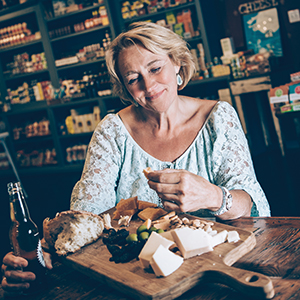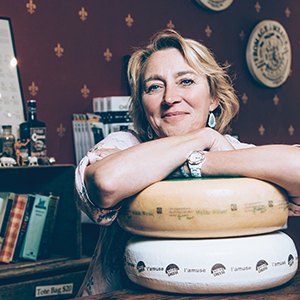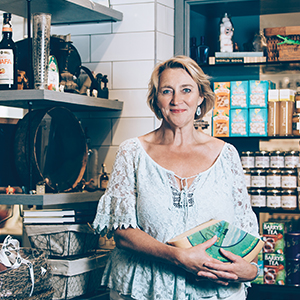While the Netherlands is renowned for its 17th century old master paintings, IJmuiden-born Betty Koster is famous these days for refining another local art form with 12th century antecedents. In the realm of Dutch masterpieces, cheeses from Koster’s Fromagerie L’Amuse — including her signature two-year warm-cellar-aged Gouda L’Amuse and Brabander, an uncommon goat Gouda — are celebrated as among the very finest cheeses in Holland and beyond. Only a few are imported into the U.S.

Gouda is one of the oldest cheeses on record that is still made today. The name refers not to where the cheese was originally made but to the town by that name in southern Holland where the wheels were first traded.
In 1989, cheese affineur Betty and her husband Martin started Fromagerie L’Amuse. Their shops in Amsterdam and a second in IJmuiden offer an unrivaled selection of European cheeses, along with charcuterie, condiments and beverages to serve with them.
I asked Betty Koster how she came to be considered Holland’s ultimate cheese expert.
CC: Was your family always involved in making cheese?
BK: When I was growing up, my maternal grandmother had a cheese store in Haarlem, and I loved going there. Even as a little kid, I always wanted to hold a knife. I worked at the store and in the stall at the market for five or six years and started to learn how to make cheese and also about selling them. As I met different producers, they also helped educate me.
On the other side of my family, my daddy was a sailor and, because I wanted to be like him, I dreamed of going to sea. But the teachers at school laughed at me and said I’d get too homesick, so I didn’t follow up on that. Next, I decided to study languages because I thought I could become an airline stewardess and travel. Having learned to speak French eventually helped me when I decided to study the great cheeses of the world.
At 25, I got a job with a cheese wholesaler in Amsterdam. The owner said I did a very good job. When they opened a new, second store—kind of like Eataly with cheeses from all over Europe—he wanted to make me the head buyer rather than working with the restaurants and producers as I had been doing. But I really loved the many relationships I had built with the farmers, cheese makers and affineurs, and didn’t want to be cut off from them in an office job.
My dad also said he didn’t pay for my studies for me to become a salesperson in a cheese shop. I promised him that one day I would make him proud. Toward the end of his life, he was the chauffeur who drove the cheeses to the restaurants who bought our cheeses, and he was very proud of me.

CC: Talk about the transition into your own cheese business.
BK: In 1989, my husband Martin and I decided to launch Fromagerie L’Amuse in Haarlem, rather than working for someone else. It was easy, as we already lived there.
We chose the name L’ Amuse, derived from l’amuse gueule in French that translates as “caressing the tongue.” That is what cheese does, and we did tastings, exposition and master classes to entertain people.
I already had very strong opinions as an affineur and immediately started to develop and finish cheeses with the L’Amuse label in a manner that I felt would make a difference. It had become obvious to me that maturing was the key. As for the reactions of others, I didn’t care to notice that people liked our cheeses better.
Internationally-known cheese authority, author, chef and educator Daphne Zepos came to Holland with all the Gouda she could buy in the States, asking me if we could improve this with Essex cheese. That was the start of L’Amuse in the U.S.

CC: You moved around Haarlem before settling in Ijmuiden.
BK: When the city of Haarlem decided to close off the streets to cars, we had to move, because as a wholesaler and traiteur (caterer), you had to have a car. We moved first to the outskirts of Haarlem, then again for a second time. For the last 11 years, we have been in IJmuiden, where I was born. It’s near the North Sea Canal that connects with Amsterdam. It makes sense, as it is near the highway so we can easily come and go and cheeses can be delivered from around the country.
The term terroir aptly applies to Dutch cheese. In Northern Holland, cows graze on fields in luscious sea clay, which pre-salts the grass the animals eat. That is great for the flavors of the cheese. In the middle of our country, three big rivers—the Maas, Rijn and IJssel—create sweet river clay where mostly there are primarily MRIJ cows, a breed named for the rivers. Those cows give milk with high levels of Omega 3s and proteins. At L’Amuse, we also mature artisanal hard and soft goat and sheep cheeses under these conditions.
Over the years, I cultivated working relationships with many fine farmers. I still maintain some of them today. In Dutch, an openlegger is the name for someone who matures Gouda-style and Dutch hard cheeses. So, if the cheese is simply matured Gouda, we name it for the village in comes from, like Stolwijker, Bodengravense, for example. When Martin and I find a farmer who ages his cheese especially well, we include his name on the wheel.
CC: The conditions and methods under which you ripen your cheeses are unique.

BK: Depending on the cheese, we receive them at the maturing rooms at various stages of ripening. Some are delivered after two days, like soft goat milk cheese; others arrive between 10 and 15 days if the cultures on the rind have to develop at the production facility, like some washed and bloomy rind cheeses. Goudas arrive at the maturing rooms after three weeks, because they
travel better at that point and the producer can be certain that they don’t have any faults.
I age my two-year old Goudas at a higher temperature than what is considered normal here. When I was learning about cheese making, Holland didn’t have a technical program, so for me it was like a gut feeling. My grandmother had a maturing room next door to her shop and I remember some of the cheeses she bought from others were more closed and had a different flavor. I was curious about why that happened.
After experimenting, I think 51 to 54 degrees is the ideal range, and also with higher humidity. For me, the limit is 59 degrees It is very hot. Past that, at 60.8 to 62.6, cheeses don’t mature well and bacteria can develop quickly. It can also acquire a dark, unattractive layer under the rind, and I think it is kind of soapy on the palate.
A degree or two less, say 57.2 to 59, which is common in Holland, or even 51.8 degrees, as is used by some companies, creates a difference in the flavor. I don’t think you achieve the beautiful crystals with coffee or caramel notes under those conditions unless you use a quick-maturing starter. But then I find you get a squishy pineapple flavor.
“Over the years, i cultivated working relationships with many fine farmers. I still maintain some of those today.”
My method helps lock moisture in the cheese, resulting in a distinctively dense but creamy, buttery aged Gouda. If a producer makes a batch that he knows will be eaten young, he can wash the curd with low temperatures (86 to 104 degrees). When he wants to mature them for over a year, he usually washes the cheese with hotter water, sometimes even 176 degrees. Martin and I select the best wheels for our Black Bettys. They are then ripened for an additional 10 months more and coated in black wax, hence their name.
Since the 17th century, men historically tended the herds while farmer ladies ran the dairies and made the butter and cheese. In the early 1900s, many small farmers decided to unite into co-ops. Although run by men, women did the production. Today, most owners are still men because they are more able to carry the heavy wheels. A bigger size equates to a better flavor. (At a shade under 6 feet and hugely successful, Betty Koster can more than hold her own as a cheese monger.)
CC: What kind of innovations do you think about going forward?
BK: Although I am always a little hesitant to make changes because I don’t want to lose what we worked so hard to achieve in terms of the quality, taste, texture and appearance, I learn from respected colleagues who use modern techniques that make things easier or better.
For example, 26 years ago I first visited Neal’s Yard Dairy in London. They implemented a kind of umbrella so the cellar was high in humidity. We used the idea of the umbrella. Imagine water running over the umbrella: that way it spreads more humidity than just a bucket with water. Lately, I noticed Neal’s had added water pipes to cool down the cellar.

CC: Who are the next generation of young cheese makers in Holland?
BK: Among the next generation of cheese makers in Holland today, I can think of five other women who are leaders in our industry. They have the physical strength and knowledge to move ahead. Going forward, I see two paths. One is the guys and girls from schools who are like economists; they go to farms to make a lot of money and consequently take away the cheese’s flavor and integrity. The other is a range of idealists who make good farmers. Many come from other businesses, like the Internet and nursing, and are ready for a relationship with the cheeses and the terroir.
CC: Your husband Martin is your partner. Was he an affineur?
BK: When we met, he was a banker and my neighbor in Amsterdam. I noticed that he left early in the morning in a suit but that when he got home he put on jeans and went out for drinks. We both had cats, so we kind of met over them. One night, there was a huge spider in my bedroom and, at the time, I was afraid of them. I asked him to remove it and I guess you could say he never left. We have two daughters. Thassia, 25, is named for the Greek island of Thassos where we got married. She is working with me to eventually take over the business. Our second daughter, Juliette, 20, is a social worker who assists people transitioning from prison back into society.
CC: Your shop carries more than cheese. Beyond wine, you say tea is also a good partner. Which ones do you suggest?
BK: The beautiful floral notes in green tea with jasmine flowers enhance the floral notes in cheese, as well. I serve it in wine glasses so the flavors of the tea come more forward. An almost-green Darjeeling, preferably a single estate, melts with the cheeses, presenting aromatic notes in the cheese and slightly hay notes in the tea. Pu-Erh with Brie de Meaux is like an ultimate autumn expression! When paired with Brabander goat, the tea also emphasizes the cheese’ caramel taste, and afiletta from Corsica becomes a beloved cheese by everybody, although it can smell like hell.

CC: You also cook with your cheese. What kind of dishes do you make?
BK: I make big pots of fondue and sell in the store because everyone loves it.
For a barbecue, I stuff chicory leaves with Gorgonzola and pancetta and grill them.
Mushrooms are delicious when stuffed with Gruyère and egg. I wrap Feta cheese in foil with Spanish peppers, heat it in the oven, and then open it for people to dip bread into.
I slice the top off a boule de campagne and remove enough of the insides for a Mont d’Or cheese to fit inside. I cut off the top of the cheese, stud it with slivers of garlic, some rosemary and thyme; return the lid and bake in the oven for at least 30 minutes.
CC: Finally, what are a couple of your favorite cheeses, other than your own?
BK: There is such a wide range, including Roquefort Caves Baragnaudes, matured in caves for three to four months. It is creamy and rich. Another is Lactic goat cheese like Crottin de Chavignol. And Wrangelbackost, a Swedish washed rind cow’s cheese, has been made in the same premises for thousands of years so all the cultures are still there.



